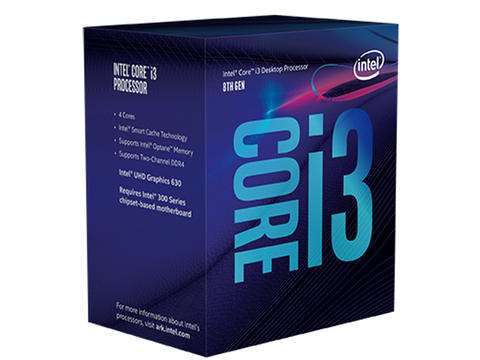Early Verdict
Intel's Core i3-8100 offers four physical cores for a mere ~$120, which is a tremendous value compared to the previous generation Intel models. We'll be even more impressed when reasonably priced B350 motherboards come to market.
Pros
- +
Four physical cores
- +
Good mix of gaming and application performance
- +
Low price
- +
Capable stock cooler
Cons
- -
Locked multiplier
- -
No B-series motherboards (yet)
- -
No Hyper-Threading
Why you can trust Tom's Hardware
Meet Intel's Core i3-8100
Intel's Coffee Lake architecture represents the company's biggest generational improvement in more than a decade. Specifically, though, its Core i3 models benefit most. In the past, Core i3 chips wielded two Hyper-Threaded cores. But Coffee Lake-based i3s sport four physical cores. On paper, that makes them roughly equivalent to Kaby Lake-based Core i5s at lower prices.
The improvement was badly needed. AMD's Ryzen 3 1300X and 1200 offered unlocked ratio multipliers and twice as many cores as previous-gen Core i3s, earning our unabashed praise. Intel tries leveling the playing field with Coffee Lake. In response, AMD slashed prices on its Ryzen 5 and 7 CPUs.
Part of our list of best CPUs for desktop applications at press time, the Core i3-8100 competes at a price point where AMD might not be able to get much more aggressive. All Ryzen processors utilize the same eight-core die, so there is a fixed manufacturing cost, even for the four-core Ryzen 3 models.
Although Intel only sells two Coffee Lake-based Cores i3s for now, there's a $60 chasm between the Core i3-8100 and unlocked Core i3-8350K. And that K-series chip isn't a typical Core i3. It doesn't come with a bundled cooler, it requires a pricey Z-series motherboard for overclocking, and it only costs a few dollars less than the six-core Core i5-8400. Naturally, we recommend stepping up to the higher-performance CPU.
Core i3-8100, on the other hand, fits neatly into the familiar mainstream pricing structure and is a good complement for the B-series motherboards due to arrive early this year. Selling for $121 online, it's Intel's only real competition against Ryzen 3 1300X and 1200.
The Core i3-8100
Intel's entire Coffee Lake line-up operates at lower base frequencies than its Kaby Lake chips due to the prevalence of extra cores. For the Core i7/i5 families, Intel offsets those conservative clock rates with higher Turbo Boost bins. But Core i3-8100 doesn't benefit from Turbo Boost. That means you get a static frequency, regardless of how many cores are active. So, the -8100's 3.6 GHz ceiling could yield lower performance in lightly-threaded workloads compared to the 3.9 GHz Core i3-7100.
Of course, four physical cores should also translate to a big speed-up in heavily-threaded tasks favoring Core i3-8100. Extra cores naturally use more power, so Core i3-8100 carries a 65W TDP versus Core i3-7100's 51W rating.
The i3's cores come with 1.5MB of cache each, adding up to 6MB of L3 across the die. Core i3-8350K boasts 2MB of L3 cache per core, for a total of 8MB. Meanwhile, the Ryzen 3 models sport 8MB of L3 cache as well. As we've seen, though, in real-world applications, cache latency and throughput can drag down the advantage of higher capacity. Our benchmarks will sort out the winners.
Coffee Lake-based Core i3s support the same DDR4-2400 transfer rate as Kaby Lake models, while Core i5s and i7s now accommodate up to DDR4-2666. The Core i3-8100 includes UHD Graphics 630 on-die, which is essentially the same as Kaby Lake's integrated graphics engine. This gives Intel an advantage over AMD's Ryzen processors if you aren't planning on using a discrete GPU.
Intel lists the Core i3-8100 at $117, which matches the Kaby Lake-based Core i3-7100. Coffee Lake pricing has improved alongside availability, and we're now seeing this chip online for ~$121. It naturally does battle, then, with AMD's $130 Ryzen 3 1300X and $110 Ryzen 3 1200. Let's see how they stack up.
MORE: Best Cheap CPUs
MORE: Intel & AMD Processor Hierarchy
MORE: All CPUs Content

Paul Alcorn is the Managing Editor: News and Emerging Tech for Tom's Hardware US. He also writes news and reviews on CPUs, storage, and enterprise hardware.
-
MCMunroe Why does the little green button to buy the product always have a wildly higher price than the assumptions made in the article?Reply
Just a glaring sign that the articles value comparison is off, in real life. -
marcelo_vidal I don't see the point of this review? This get the UPDATE ? Bios UPDATE Microcode Update ? Where is the meltdown TRAIN ?Reply -
JQB45 Tesetilaro - Passmark benchmark results comparing the i3-8100, i5-4570 and the i5-3570.Reply
https://www.cpubenchmark.net/compare.php?cmp=3103&cmp=1896&cmp=827 -
Martell1977 I have to agree, knowing that these reviews can take some time, I'm curious (as the others) if these tests include the S&M fixes?Reply
The performance loss might change the results here significantly. I know it's a lot of work, but I think we need new benchmarks for pretty much all Intel's new models. The current numbers are no longer accurate. Maybe retest some of AMD's to see if there is much, if any effect on their performance as well.

